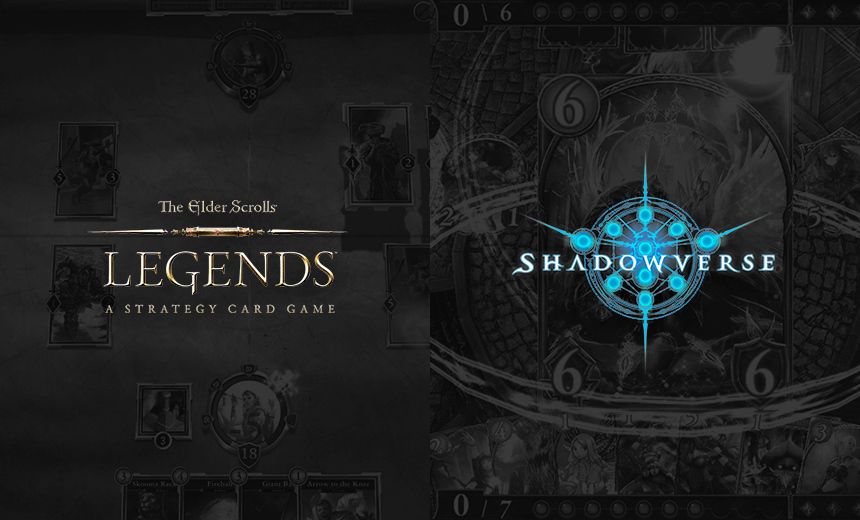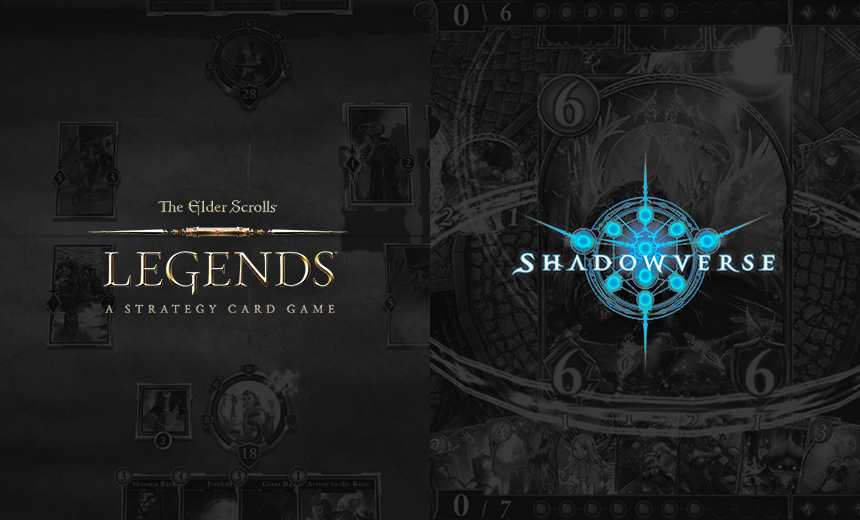
PREVIOUSLY ON "Beyond Hearthstone":
Duelyst and Faeria
Eternal and GWENT
With the third edition of "Beyond Hearthstone", we end our short trip around CCG land. Having seen the miniature warfares of Duelyst and Faeria and the strategic complexities of Eternal and Gwent, we now arrive at two titles which are closer to Hearthstone than anything else.
In Shadowverse, anime-styled armies evolve and battle in lavishly animated bouts, while Legends explores the mature, high-fantasy world of The Elder Scrolls by layering combat in the interest of in-depth gameplay.
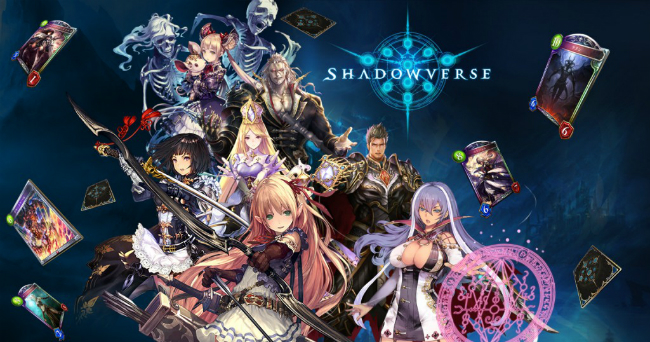
Developer: Cygames
Factions: 7
Unique mechanics: Evolving
Text by: Matthieist
Shadowverse is arguably Hearthstone’s biggest competitor at the moment. SuperData published an overview of CCG’s, showing that Shadoverse’s estimated revenue in 2016 was about a quarter of Hearthstone’s revenue in the same year. That might not seem impressive, until you realize that Shadowverse launched in June of that year. In about half a year, the game has grown so massively in popularity, that it made about a fourth of what gaming giant Blizzard’s Hearthstone made in an entire year.
It is easy to see why many CCG fanatics are attracted to the game, especially when coming from Hearthstone. Shadowverse has many similarities with Hearthstone, but has included many things Hearthstone players have been wishing for since launch. First of all there is the large availability of information. With one click on your profile you can see how many wins per class you have or how much XP it will take to level up a certain class. There are live in-client leaderboards displaying those with the highest points (think MMR), those who excel at certain classes (ranked win by class) and a ‘Take Two’ leaderboard (Shadowverse’s version of Arena). Additionally, in-game, the entire battle log can be scrolled through – something Hearthstone players have wanted for ages.
However, the abundance of information is not the only thing Shadowverse just does right. Although the deckbuilding itself is done in similar fashion to most digital card games, importing decks is incredibly easy. Because, let’s be real, after spending time crafting our own decks and winning 1 in 10 matches with them, we’ve all reached a point on which we netdecked. Copying decks to your own account, though, often requires quite some alt-tabbing, or reading it off another screen. Using its digital environment to the fullest, Shadowverse has deck codes tagged to decks posted online. Simply copy the code, paste it in-client, and it uploads the deck in your deckbuilder (minus the cards you don’t have yet, of course).
In terms of unique gameplay mechanics, Shadowverse doesn’t boast that many and those it does feature don’t function in an exceptionally unique way. The most prominent mechanic is probably ‘evolve’, allowing a player to give an upgrade to a friendly follower (minion) on board which usually means it gets around +2/+2 in stats, although some followers trigger a special effect when evolved. In addition to a boost in strength, the evolved follower can also attack immediately, although only enemy followers can be attacked. It calls for strategic planning, making players decide between protecting their own board or going for that swing.
Apart from evolving minions, Shadowverse’s seven classes each have their own trait. For example: Swordcraft builds around the synergy between to types of followers, Runecraft finds strength in combining spells with other cards and Bloodcraft aims to lower a player’s own health in order to utilize very powerful effects. Combine this with standard card game mechanics such as Ward (Taunt) and Ambush (Stealth), and you’ve got yourself enough mechanics to make the game feel fresh.

Honestly, I could write an entire essay on what Shadowverse does well. Apart from the access to information, deckbuilding ease and fresh-feeling gameplay mechanics, Shadowverse has fully customizable profiles, the option to buy full decks (great for newer players) and since its launch in June has had a 100+ card expansion every three months. It can even record the games you play for you, so you can come back and analyze plays at a later moment (or properly record that one crazy moment to get some sweet Reddit karma). For players who are tired of the RNG in Hearthstone Shadowverse is a great alternative too, as the developers have stated they want to have as little RNG in the game as possible.
So isn’t there anything Shadowverse does wrong? Well, perhaps it’s not exactly wrong, but the pacing of the game feels… off for a card game. Set in an anime universe, a game of Shadowverse appears to be trying to capture the combat style seen in animes or in MMO’s like Blade and Soul. Animations fly across the screen in the blink of an eye and before you know it, the game is over. Compare this to Hearthstone – a game also advertised as a fast-paced strategy game – or Eternal, and you see why this feels weird for a card game.
Card games are inherently slow-paced due to the strategic depth combined with a turn based system, and it is important for their digital counterparts to embrace that. A great example is [card]Ragnaros the Firelord[/card] who takes his time creating his ball of fire and picking a target, but even basic attacks of minions in Hearthstone are quick, but clear. If you don’t know all the cards in Hearthstone you have time to figure out what that one special card your opponent played does, but in Shadowverse you’re overwhelmed. Even when playing against AI I spend minutes staring at the battle log to find out what just happened. For seasoned players who know all the cards, of course this isn’t a big issue. But for new or casual players it can be confusing, and therefore make the game inaccessible.
Despite the pacing, Shadowverse makes for a great game. It picks up on many things Hearthstone is missing, and implements them in fantastic manner. I doubt that - in the near future - it will challenge Hearthstone in other ways than revenue, as Hearthstone is backed by the immense engine that is Blizzard Entertainment. Shadowverse is, however, a fresh alternative for any card game lover, and I wouldn’t be surprised (in fact, I highly recommend it) if the Hearthstone developers take some good notes from it.
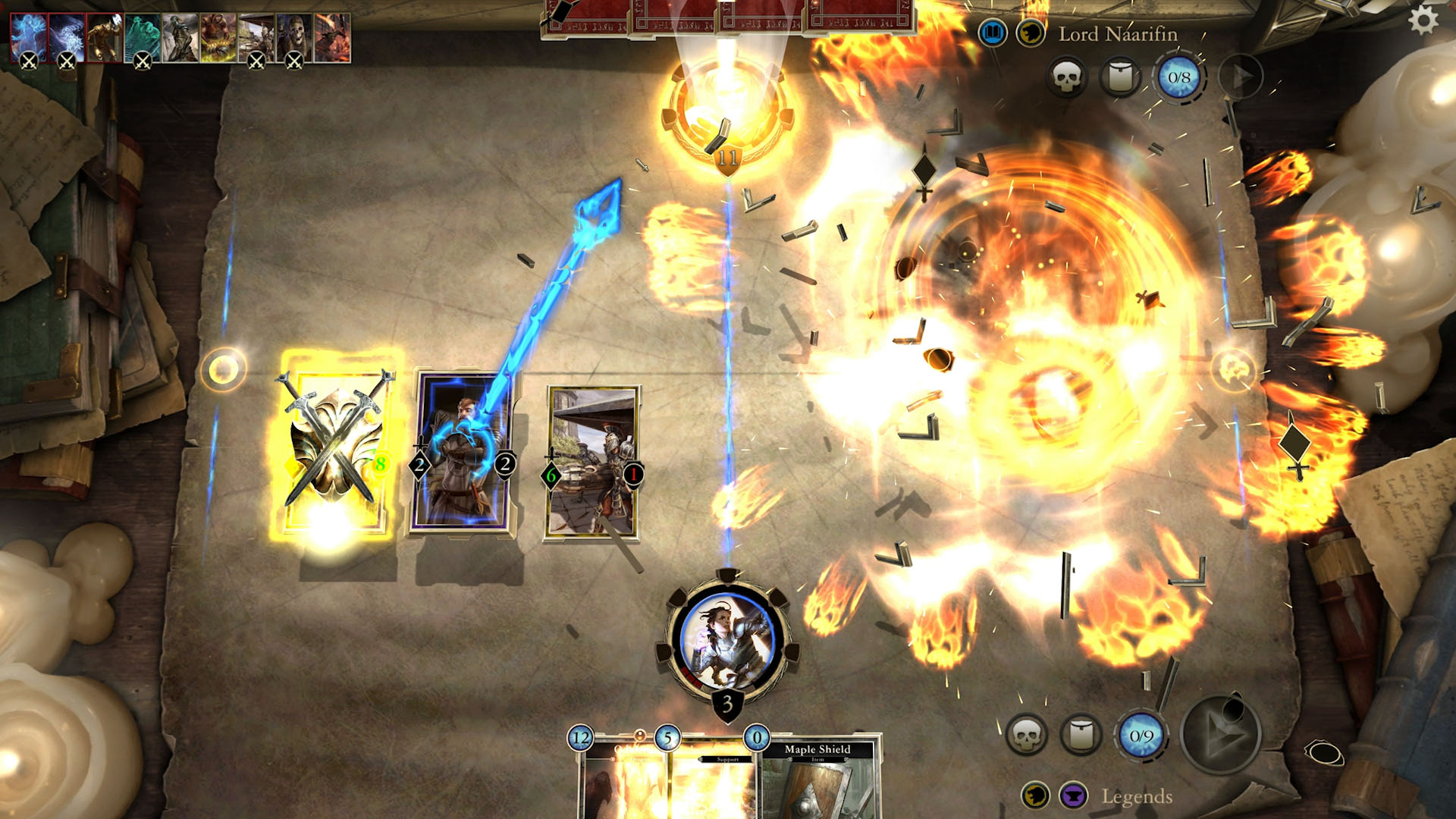
Developer: Dire Wolf
Factions: 5
Unique mechanics: Lanes, runes, dual-classing
Text by: Nydra
Of all the games we’ve examined thus far, The Elder Scrolls: Legends is by far the closest to Hearthstone in terms of experience. The two games have a similar card collection acquisition speed, share the same combat principles where the attacking player decides whether go for minions or face, and use a lot of the same keywords, some of which have been simply renamed. If you’re coming from Hearthstone, you’ll fit right in…
…At least for the first few games. As with each CCG presented in this mini-series, Legends also has its own spin on the Hearthstone fundamentals in attempt to be more in-depth than Blizzard’s product. In Legends, the battlefield is split into two vertical lanes and minions can be placed in either one and—usually—only affect other minions on the same lane. Therefore, Hearthstone’s straight-forward battle here becomes multi-layered, where players can slalom between left and right to avoid or create threats depending on each player’s decisions.
What makes this lane-splitting even better is the fact that lanes have different effects. The left lane is your standard battlefield where nothing special ever happens but on the right lies the Shadow lane, where each minion is protected from attacks for one round when it enters the battle. The simplest example of use of the two lanes would be “Play charge minions in left lane and go off, but place high-value threats who need to survive in the Shadow lane”. If there were Druids in Hearthstone that had that option, you know they’d be placing Fandral in the Shadow lane all day long, for instance.
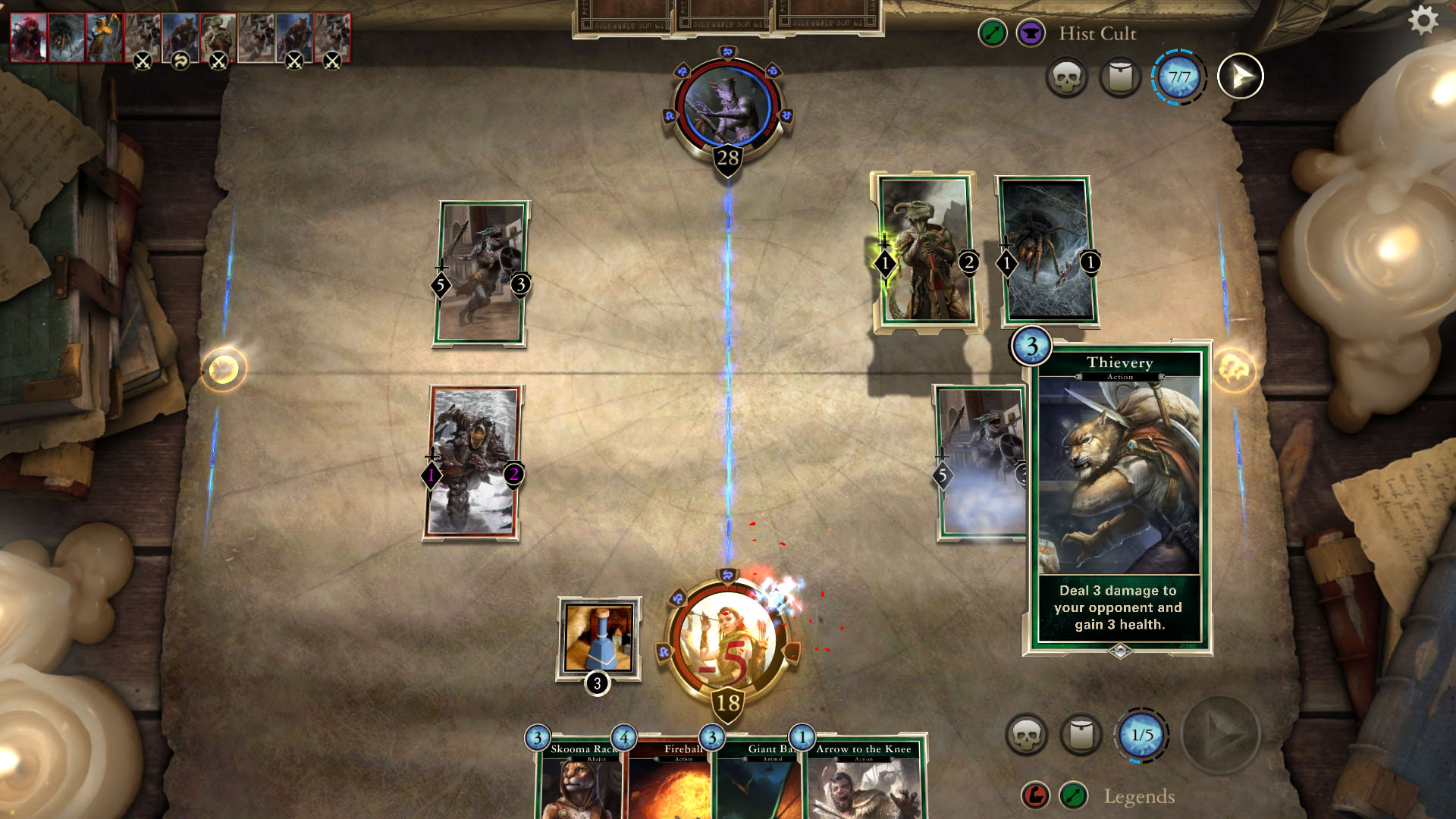
The battlefield split brings a lot of strategic depth to Legends, as expected, as the amount of decision making compared to Hearthstone is squared. Do I overcommit minions to one lane in attempt to establish dominance there at the risk of a lane swipe spell? Or do I balance Left and Shadow to play against removals at the expense of weakened battle math?
Another great mechanic in Legends are the Runes, which are there to combat snowballing decks and help the losing player to get back into the game. When a player’s health drops below one of the five thresholds at 25, 20, 15, 10 and 5 health, an extra card is drawn. What makes the mechanic even more powerful is the keyword “Prophecy” which allows cards drawn through the Runes to be played immediately and for free. The effects on Prophecy cards range from innocent ones such as playing a vanilla minion to match-turning ones such as dealing 1 damage to all enemy creatures in a lane, the latter of which can easily disrupt the plans of aggressive decks which rely on low-health tokens to overwhelm.
Legends will also be appreciated by fantasy fans who don’t appreciated the goofy themes of Hearthstone or the anime art of Shadowverse. True to the style of the games, TES: Legends is a mature take on high fantasy—beautifully drawn at that—and treats the war of sword and sorcery with the seriousness it demands.

